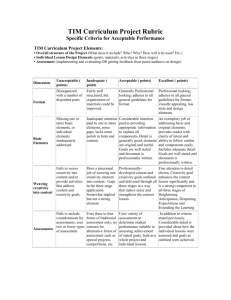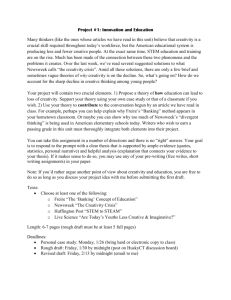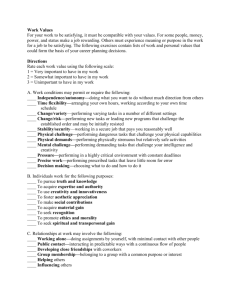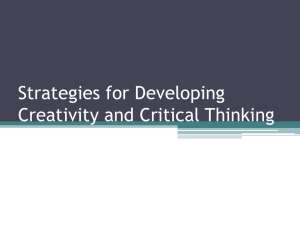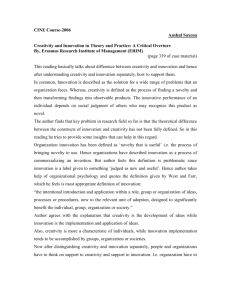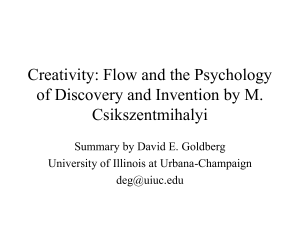Creativity Powerpoint
advertisement
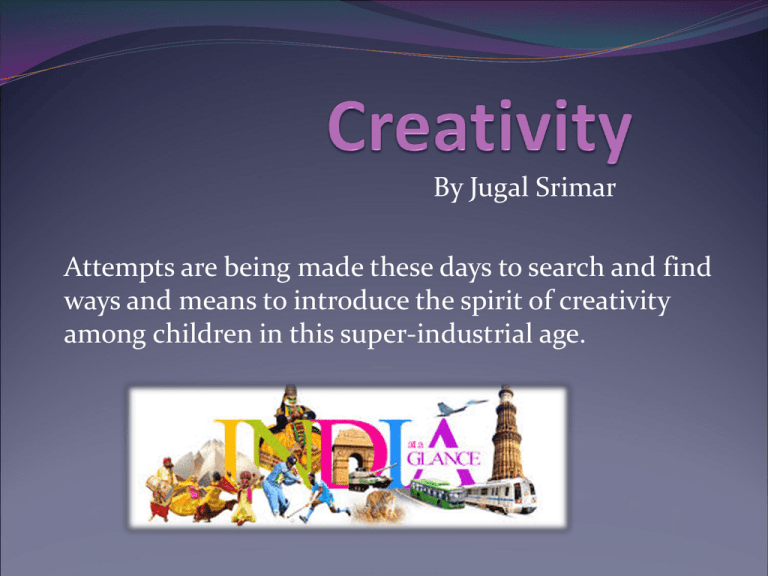
By Jugal Srimar Attempts are being made these days to search and find ways and means to introduce the spirit of creativity among children in this super-industrial age. “Education is the field where we have done worst in India, I believe, because we have provided education for the mind only and not the character.” Lord Wavell, Governor General of India writing to George VI (King of England) in 1946 Change has occurred during the last four decades: Art colleges confer degrees in Painting and Sculpture Child art is recognized, encouraged, accepted Children’s art contests occur all over the country with artists from over 100 countries and prizes offered by Russia, USA, and Japan An Art Contest by the Nehru Children’s Museum drew over 7,000 young artists in 1992 Creative children are not usually liked by parents or teachers because they don’t follow the rules Parents and teachers must be prepared to face conflict from creative children One can’t expect new ideas from those who are not creative Discipline and creativity cannot co-exist because discipline leaves little room for free, imaginative thinking Over-emphasis on theoretical and academic studies in schools creates a negative impact on children’s mind development. It hinders the ability to cope with life in a rapidly changing society. The education system introduced by the British elite in the first half of the 19th century was designed to fit stereotypes to rule and run the country, not to promote initiative, alertness, awareness and creativity among children or adults. Bal Bhavan Society, a project of the government of India, is promoting creativity. It generates children’s confidence and involvement and urge for self-expression, curiosity, personality, and selfhelp. A child is given freedom to explore and experiment with his own ideas. Promoting creativity among children will gradually help bring about a change in the socio-cultural pattern of the next century. Teachers must guide children when they ask for the explanations to satisfy their curiosity. Jugal Srimal is the founder and director of Nehru Children’s Museum in Calcutta and has written numerous books on social and educational problems. Based on what we know about India today, do you think Srimal’s ideas have been listened to? What support can you give for your thinking? https://www.google.com/url?sa=t&rct=j&q=&esrc=s&source=web&cd=11&cad=rja&uact=8&ved=0CE8QtwIwCg&url=http%3A%2F%2Fwww.yo utube.com%2Fwatch%3Fv%3DrWWIVGXNK3E&ei=lxhbU-qALdGeyASgvoGACw&usg=AFQjCNETdwF6mgekwBuMMtMhN5d5w_XrRg http://www.nehrumuseum.org/founder.html What about American education? How are we doing here and now? How about education in China? The Creative Mind Pearl Buck The truly creative mind in any field is no more than this: A human creature born abnormally, inhumanely sensitive. To him… a touch is a blow, a sound is a noise, a misfortune is a tragedy, a joy is an ecstasy, a friend is a lover, a lover is a god, and failure is death Add to this cruelly delicate organism the overpowering necessity to create, create, create,-so that without the creating of music or poetry or books or buildings or something of meaning, his very breath is cut off from him. He must create, must pour out creation. By some strange, unknown, inward urgency he is not really alive unless he is creating. Pearl Sydenstricker Buck (June 26, 1892 – March 6, 1973), also known by her Chinese name Sai Zhenzhu Sài Zhēnzhū), was an American writer and novelist. As the daughter of missionaries, Buck spent most of her life before 1934 in China. Her novel The Good Earth was the best-selling fiction book in the U.S. in 1931 and 1932 and won the Pulitzer Prize in 1932. In 1938, she was awarded the Nobel Prize in Literature "for her rich and truly epic descriptions of peasant life in China and for her biographical masterpieces." After her return to the United States in 1935, she continued her prolific writing career, and became a prominent advocate of the rights of women and minority groups, and wrote widely on Asian cultures, becoming particularly well known for her efforts on behalf of Asian and mixed race adoption. Wikipedia We can always do better, right? Even your teacher can go from 2 to 6! And she can learn when to stop or not…you know I can’t




